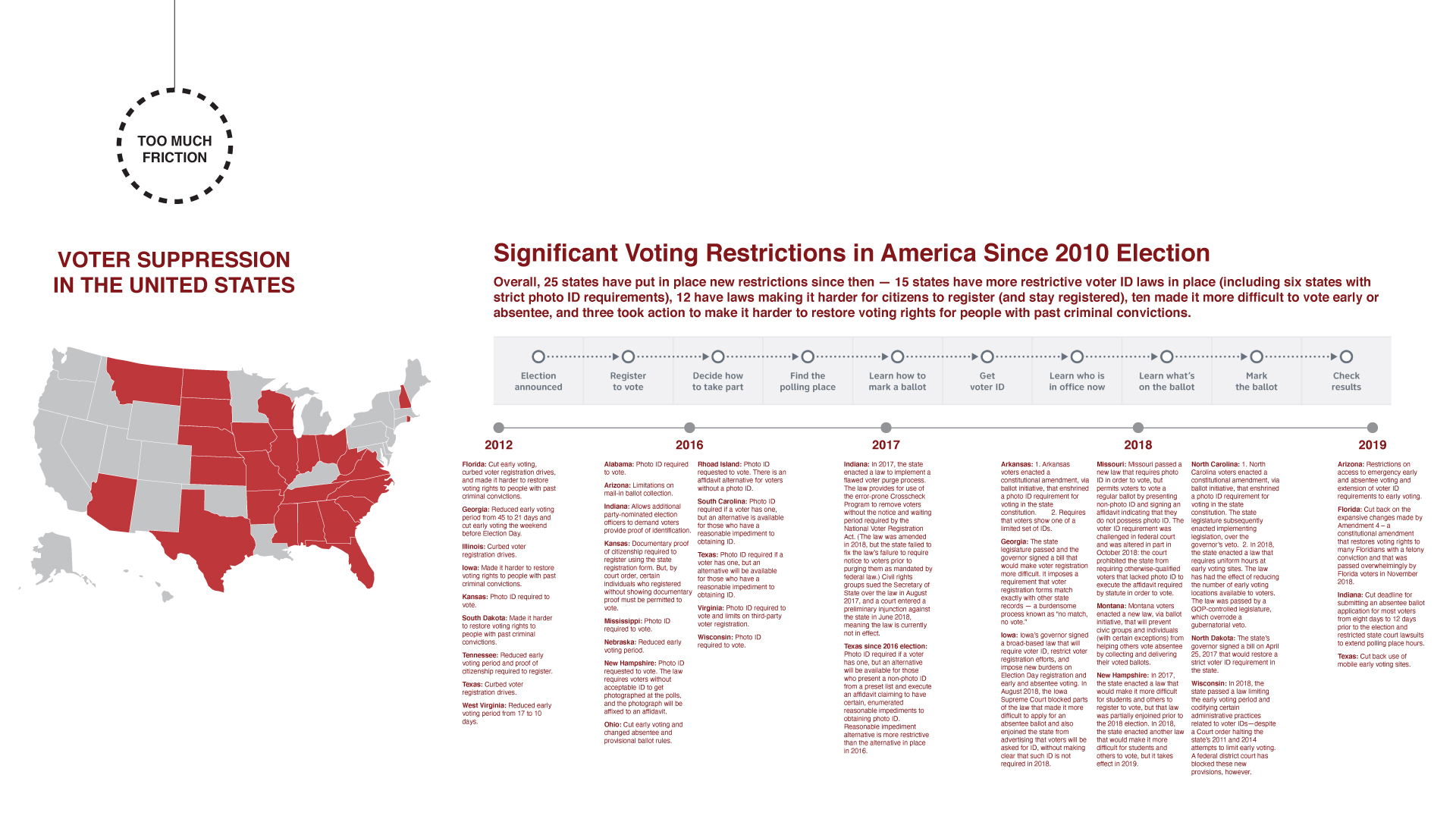I examined how friction functions in a broader context in political, social, and economic systems, and how that friction affects our lives.
As a case study, this infographic shows gun regulations and voter suppression in the United States to understand the relationship between friction and action. Both cases have several steps to achieve the goal and the level of difficulty to reach that point differs from country to country or state to state.

This map particularly illustrates how easy and simple to buy a gun in the United States compared to 15 other counties. One of the articles in the New York Times, Audrey Carlsen and Sahil Chinoy said that getting a gun in the U.S takes less than an hour whereas it takes months in some countries. It can be assumed that easy access to guns takes responsibility for a high rate of gun-related killings. According to BBC News, “About 40% of Americans say they own a gun or live in a household with one, according to a new Pew Research Center study in 2017 survey, and the rate of murder or manslaughter by firearm is the highest in the developed world. There were almost 11,000 deaths as a result of murder or manslaughter involving a firearm in 2017.” The process of owning an object affects its value to the owner. Americans perceive guns as more like a commodity, like any other daily products, rather than as weapons.

On the other hand, many states in the United States have been adding more voting restrictions since the 2010 election. According to “New Voting Restrictions in America” by Brennan Center for Justice, “Overall, 25 states have put in place new restrictions since then — 15 states have more restrictive voter ID laws in place (including six states with strict photo ID requirements), 12 have laws making it harder for citizens to register (and stay registered), ten made it more difficult to vote early or absentee, and three took action to make it harder to restore voting rights for people with past criminal convictions.” By increasing friction in a voter’s journey, voters are discouraged by the multi-step process, and voting becomes troublesome work.
I would like to argue that we, designers, need to have a better understanding of friction and the concept of friction in many contexts offers an ethical standard for designers as well as critical thinking for users.
Through researching this historical/contextual framework, I learned about the interaction between systems and perception, and regardless of the subject, the amount of friction plays an important role in balancing and forming an individual’s perspective of value. To further investigate my thesis, the concept of “affordance” comes into the study, which explains human perception of understanding an environment.
Affordance
According to Joanna McGrenere, a computer scientist from the University of Toronto, the concept of affordance is popular in the Human-computer interaction community, but the definition is ambiguous when we compare Gibson’s original definition and Norman’s appropriation considering widespread usage. My definition is related to Norman’s use of the term, where perception may be as important as actual properties. For Norman, affordance is the perception of what an environment offers to a user. Here, the “environment” is synonymous with the “digital interface.” For this thesis, affordance is the perception of what a digital interface can offer a user. As Norman points out, the environment can offer clues as to how to behave. Affordance demonstrates the direct connection of 'perception-action,' which shows human's understanding of the environment, and can lead to possible action. For example, the red color of an apple induces a picking up and eating behavior, and the particular height of a well-designed chair supports sitting behavior. I suggest that friction will serve as an affordance to induce positive behavior and allow for a particular view of an issue, by designing the optimal amount of friction, depending on the subject.
Affordance
According to Joanna McGrenere, a computer scientist from the University of Toronto, the concept of affordance is popular in the Human-computer interaction community, but the definition is ambiguous when we compare Gibson’s original definition and Norman’s appropriation considering widespread usage. My definition is related to Norman’s use of the term, where perception may be as important as actual properties. For Norman, affordance is the perception of what an environment offers to a user. Here, the “environment” is synonymous with the “digital interface.” For this thesis, affordance is the perception of what a digital interface can offer a user. As Norman points out, the environment can offer clues as to how to behave. Affordance demonstrates the direct connection of 'perception-action,' which shows human's understanding of the environment, and can lead to possible action. For example, the red color of an apple induces a picking up and eating behavior, and the particular height of a well-designed chair supports sitting behavior. I suggest that friction will serve as an affordance to induce positive behavior and allow for a particular view of an issue, by designing the optimal amount of friction, depending on the subject.
Bibliography
- BBC News. “America's gun culture in charts.” BBC. August 5, 2019. https://www.bbc.com/news/world-us-canada-41488081
- Carlsen, Audrey, and Sahil Chinoy. “How to Buy a Gun in 16 Countries.” The New York Times. The New York Times, March 2, 2018. https://www.nytimes.com/interactive/2018/03/02/world/international-gun-laws.html.
- Coburn, Ginny. “The Epic Journey of American Voters.” Center for civic design, September 18, 2018. https://civicdesign.org/the-epic-journey-of-american-voters/.
- Gibson, James J. “The Ecological Approach to Visual Perception.” New York, NY: Psychology Press, 1979.
- “Gun Control.” Wikipedia. Wikimedia Foundation, September 20, 2019. https://en.wikipedia.org/wiki/Gun_control.
- McGeveran, William, "The Law of Friction," University of Chicago Legal Forum: Vol. 2013: Iss. 1, Article 3. Available at: http://chicagounbound.uchicago.edu/uclf/vol2013/iss1/3
- McGrenere, Joanna. “Affordances: Clarifying and Evolving a Concept,” Proceedings of Graphics Interface, May 2000.
- “New Voting Restrictions in America: Brennan Center for Justice.” New Voting Restrictions in America | Brennan Center for Justice. Accessed September 30, 2019. https://www.brennancenter.org/new-voting-restrictions-america.
- Norman, Donald A. The Design of Everyday Things. Cambridge, MA: The MIT Press, 2013.

